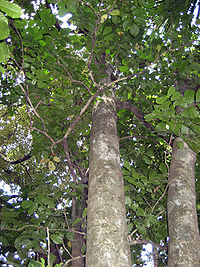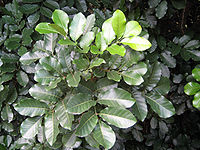- Kohekohe
-
Dysoxylum 
Kohekohe (Dysoxylum spectabile) Scientific classification Kingdom: Plantae Division: Magnoliophyta Class: Eudicotyledoneae Subclass: Rosidae (unranked): Eurosids II Order: Sapindales Family: Meliaceae Genus: Dysoxylum Species: D. spectabile Binomial name Dysoxylum spectabile
L.Kohekohe (Dysoxylum spectabile) is a medium-sized tree native to New Zealand. It is found in lowland and coastal forests throughout most of North Island and also occurs in the Marlborough Sounds in the north of the South Island. Mature trees grow up to 15m in height, with a trunk up to a metre in diameter. Kohekohe forest used to be common in damp coastal and lowland areas in the North Island, but these forests have mostly disappeared because the land was used for settlement or they were browsed by possums. A fairly close relative of true mahogany (Swietenia), it is also called New Zealand Mahogany.
Kohekohe is notable for having characteristics normally associated with trees growing in the tropics, for example, it has white flowers which grow directly from the trunk or branches, and it has large, glossy, pinnate leaves up to 40mm in length. Kohekohe is sometimes known as New Zealand Mahogany, because its wood is light, strong and polishes to a fine red colour.
Māori boiled the bark in water and drank it as a tonic. The wood was used for building canoes but the wood is soft and not as durable as hardwoods and tends to rot quickly. It is valued for carving. Kohekohe was probably the dominant vegetation cover on Kapiti Island before it was cleared in the early 19th century for cultivation and farming. The kohekohe forest on Kapiti is recovering after possums were eradicated in 1986.
Categories:- Trees of New Zealand
- Trees of mild maritime climate
Wikimedia Foundation. 2010.


